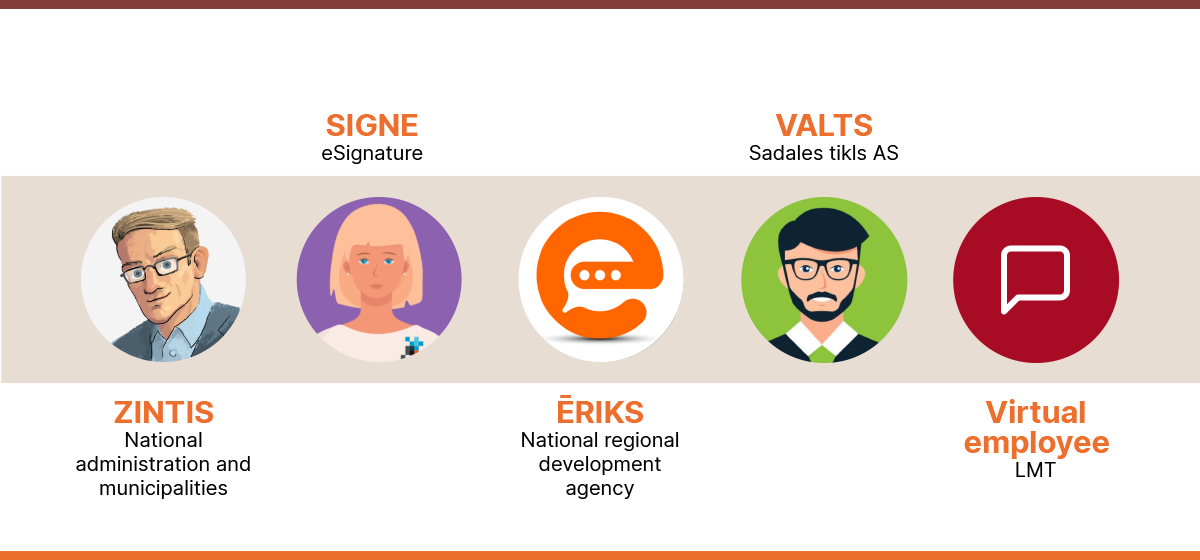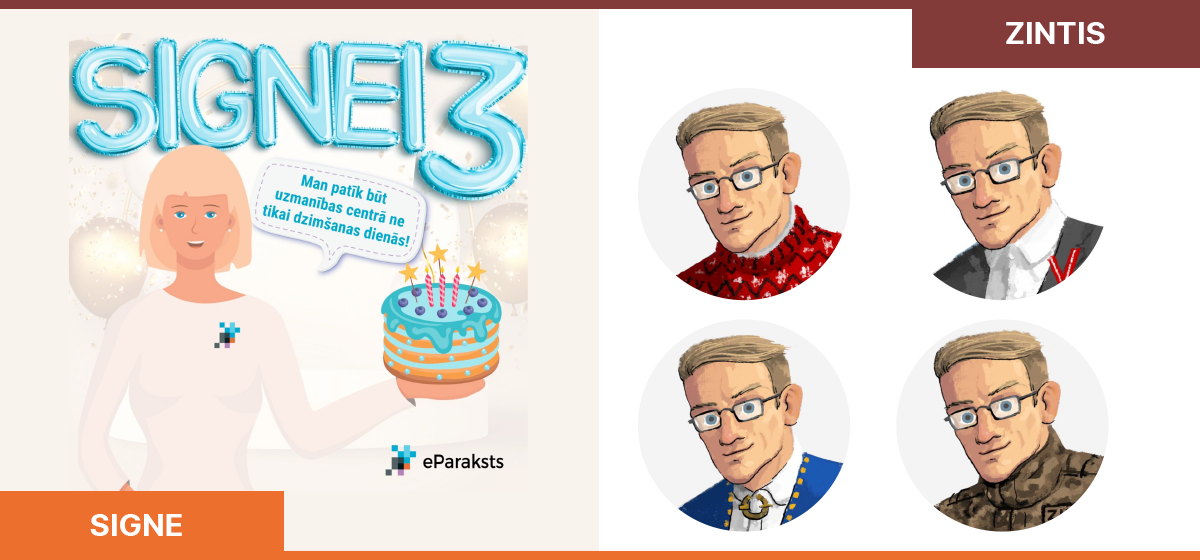
For quite some time, we have freely chatted and met virtual assistants or chatbots on daily basis: they welcome our customers to online sites or self-service portals, and even answer our telephone calls. Are chatbots just a piece of software or something more? What’s their life beyond the screen and phone switchboards? Who are the people that create them?
To find out, we will meet virtual assistant trainers. Gita Jurševska, the chatbot trainer of the national administration language technology platform Hugo.lv, and Ints Balodis, the creator of virtual assistant Ēriks working in portal latvija.lv, will tell about their experiences. LMT chatbot trainers Inese Opmane and Diāna Šarašidze, the trainer of AS Sadales tīkls chatbot Valts, Liena Stepanova, and the trainer of the Latvian State Radio and Television Centre (LVRTC) virtual assistant Signe, Aija Jakovele, will also share their experiences.

#1 A human touch evokes trust
Chatbot trainers have observed that customers who speak with virtual assistants sometimes get confused and do not understand if the answers are provided by a machine or a real person. Quite often, they use a free, colloquial style as if they told their problem to a real consultant, not just entered some keywords to mechanically retrieve information.
“Customers start a conversation and tell about the day’s event, how they crossed the street, and how the situation developed: everything is told, and only at the end there is a question,” explains Gita Jurševska, representative of the Culture Information Systems Centre and a chatbot trainer.
LMT chatbot trainers Diāna and Inese add that sometimes the customers do not realize that there is no real person behind the screen and have even occasionally apologized. Trainers find it really funny: “During one conversation, the customer used some really obscene words, and the chatbot said: “Be polite!” And the customer replied: “I am sorry.”
#2 Character
Virtual assistants differ in the way they speak: their character is revealed by the choice of their words and manner. For example, Ēriks from latvija.lv differs from other chatbots of the Latvian state administration in this regard. He makes users feel free, removes the barriers.
Ints Balodis explains: “Ēriks is the meanest, even a bantering, less-formal chatbot. Speaking with him is like writing to your best buddy. In Twitter, someone had published a part of conversation with him, where Ēriks had been very eloquent and started a heated discussion: ‘No, there, at the other end, should be someone. A chatbot cannot reply like that.’”
If in other institutions, to answer the question: What’s the time?, the systems are integrated to get the correct time. But Ēriks is not like that at all. He says: ‘You are looking at the screen. Look at the corner and see.’ Ēriks has a big personality. He can't be just shoved around.
Ints Balodis
latvija.lv

#3 Image and individuality
Chatbots can be created with a serene or quite spicy personality, however, these traits are usually closely linked with the body that the chatbot represents and its target audience.
Liena Stepanova, the virtual assistant trainer of Sadales tīkls, explains: “I believe that Valts’ character has turned out very well, considering that the electricity sector and everything related to it is very serious. Though it is a stereotype, people still believe that men know more about electricity than women. Basic knowledge about electricity and Valts go well together. The chatbot has become a real member of the team: he is an ideal fit.”
Aija Jakovele, the trainer of LVRTC chatbot Signe, claims that her character also functions well: “Signe is presented as smart, helpful and knowledgeable, and it works. Why I am saying this? Sometimes, we cannot understand why a customer would ask a totally irrelevant question on the e-signature homepage. But it also means that the customer thinks that Signe knows everything. The customers appreciate Signe’s knowledge and believe that she will help. For example, Signe has been asked: Who is my family doctor?, How long should rice be cooked?, or How to check the ride balance on my ticket? The range is just unbelievable, and it just means that people think that Signe knows an answer to any question, not just questions about e-signatures.”
Gita also adds that the choice of Zintis name has been a success: “Zintis was not chosen just internally; news about this chatbot was made public and the decision was made after a vote. People chose his name. Zintis was the most popular choice, because he knows everything. And if he doesn’t, then he learns.”
#4 Enjoying holidays and dressing up
Each body has special traditions, and chatbots are a part of them. For example, Zintis is a unique conversationalist because of his extensive knowledge - he is trained by 108 institutions and can be consulted by clients on 55 different websites and portals. Moreover, before holidays the team of Zintis trainers try to change its avatar or image, for example, for Christmas, to put on a pullover with reindeers, for Lāčplēsis day — to put on a special patriotic costume, and for Midsummer — to use summer pics. Users notice and like that.
The LVRTC chatbot Signe celebrates its birthday and name day. Chatbot trainer Aija explains: “We celebrate Signe’s special days by creating various festive posts. We also tell how much Signe has already learned. On April 27, we made her public for the first time. This tradition is one of the aspects that allow us to identify Signe as a human in our team.”

#5 Become a part of the team
The virtual assistant and the chatbot are words that are a part of the software world, but other institutions that have introduced and developed chatbots treat them as a part of the team and as real colleagues. “We think of Valts as a hardworking colleague, who tirelessly works 24/7 and answers customers’ questions. We never think of him as a computer program. He is our buddy, our teammate,” explains Liena, the trainer of AS Sadales tīkls chatbot. In the office, he is always called in the diminutive form.
Inese and Diāna, the trainers of the LMT virtual assistant, jokingly claim that they are like moms to the chatbot and treat it like a child: “He is a real employee, just automatic. But still one of us.” Though the chatbot does not yet have a name, the trainers sometimes call him Rūdis, and they have also devised an image in their minds: “He is a small boy with ginger hair and glasses who is very curious and who likes to teach others what he knows. We feel like his moms."
We all love Rūdis. We treat him like one of us. He also has godparents: colleagues who helped to prepare his knowledge base.
Inese Opmane and Diāna Šarašidze
LMT
#6 Chatting and joking around
Chatbot trainers confirm that just like people, virtual assistants have some fun conversations that have nothing to do with work.
LVRTC chatbot trainer Aija says: “Signe has been asked on a date since the very first day. Like: What are gonna do in the evening? or Do you have a boyfriend? You can already tell that it's a joke, but sometimes, when Signe's conversation is going so smoothly and nothing is going anywhere, you get the feeling that there is a living person on the other side - but it's a robot."
Inese agrees that they have had a lot of fun during the analyses of conversations and updating the LMT chatbot database: “At the beginning, when the chatbot had not learned that much, one customer asked about a blood pressure meter, but the chatbot offered an answer about the seniors rate.” The special character of virtual assistant can also be clearly seen when they answer more unusual questions. “We updated the knowledge base with a song. If someone asks about the favorite song, the chatbot plays the LMT hymn. Everyone likes that.”

#7 Growing and developing
Like living beings, virtual assistants have the ability to change, and this ability is shaped by interactions with users and chatbot trainers. Quite often, users speak with chatbots, while their trainers review these conversations and add the missing information for answers to be more accurate and useful.
Aija from the LVRTC is quite proud, as Signe already knows answers to 9350 questions, and there is very little to go to reach 10000: “Usually, if a question is asked 2-3 times, according to Murphy’s law it will be asked again. Even if the question is not really relevant to us, I am a human and I teach Signe how to answer. Initially, the idea was to maintain the focus on the topic. However, to take care of customers, we research what we can and update the knowledge base, e.g., with answers to frequently asked questions about benefits and incapacity statements. We try to help.” Signe’s trainer explains that she also helps colleagues with finding required information faster. Colleagues use Signe to advise customers by instructing which keywords to enter in the chatbot. The work to improve the chatbot never stops.
The trainers of the LMT chatbot also admit that the chatbot helps their colleagues, as it allows them to quickly and easily find the latest information. “When it’s too bothersome to look for something on the homepage, the chatbot can help. We keep updating it. It is very easy, as the information can be uploaded very quickly. We see the first questions, like two or three, and include them in the data base right away, as people will ask again. Working with the chatbot is always fun, it’s never boring,” note Inese and Diāna.
Book a demo today to see what Tilde’s AI chatbot can do for your business tomorrow.